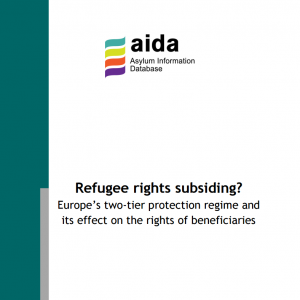Read the full report here
This report analyses Europe’s two-tier system for the protection of those fleeing persecution or serious harm. Refugee protection has evolved considerably from the adoption of the 1951 Convention Relating to the Status of Refugees (“Refugee Convention”)1 to the development of bureaucratic, sophisticated asylum systems in its States Parties. The limitations of the Convention definition of the “refugee”, heavily debated over the years,2 have been addressed through different expansive approaches to protection across different parts of the globe. Both the 1969 Organisation of African Unity (OAU) Convention Governing the Specific Aspects of Refugee Protection in Africa 1969 and the 1984 Cartagena Declaration on Refugees have codified a wider interpretation of refugeehood so as to extend protection to persons facing generalised violence or events seriously disturbing public order in their country of origin,3 on the same footing as those having a well-founded fear of persecution for reasons of race, religion, nationality, membership of a particular social group, or political opinion, as outlined in Article 1A(2) of the Refugee Convention.
The European Union (EU), on the other hand, has created a two-tier protection regime. Its Common European Asylum System (CEAS) has developed a more elaborate framework relating to the scope of persons eligible for international protection, as well as the rights attached to their status. The 2004 Qualification Directive,4 harmonising recognition standards across Member States and its 2011 recast,5 extends beyond the remit of the Refugee Convention by setting out two forms of protection available under EU law: refugee status, for persons qualifying as refugees under the Convention definition, and subsidiary protection, for those who do not meet the criteria for refugeehood but face serious harm due to certain human rights violations in their country of origin.6 Through this dual form of protection, the EU creates a complementary category of protected persons, legally and normatively distinct from refugees. This design breaks away from its own commitment to provide a “uniform asylum status, valid throughout the Union”,7 on one hand, and from other regional approaches which have extended the refugee definition, on the other. Harmonised rules and equivalent protection standards are the central premises of the CEAS. The existence of common legislative frameworks, shared financial resources and practical cooperation supported by dedicated EU agencies, should ensure that people seeking protection are treated alike in every Member State of the European Union. This assumption has never been realised, however, and continues to be dispelled by the practice of asylum administrations across the continent to date. Despite two generations of harmonised legislative standards, European countries make widely different determinations as to who needs international protection, what form of protection is needed, and what rights should be attached thereto. The “asylum lottery” has been and remains an inherent flaw in the implementation of the CEAS.
Harmonised rules and equivalent protection standards are the central premises of the CEAS. The existence of common legislative frameworks, shared financial resources and practical cooperation supported by dedicated EU agencies, should ensure that people seeking protection are treated alike in every Member State of the European Union. This assumption has never been realised, however, and continues to be dispelled by the practice of asylum administrations across the continent to date. Despite two generations of harmonised legislative standards, European countries make widely different determinations as to who needs international protection, what form of protection is needed, and what rights should be attached thereto. The “asylum lottery” has been and remains an inherent flaw in the implementation of the CEAS.
Read the full report here


